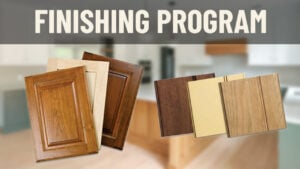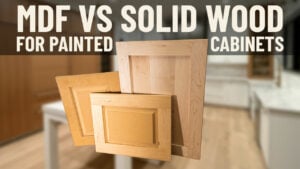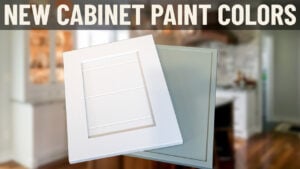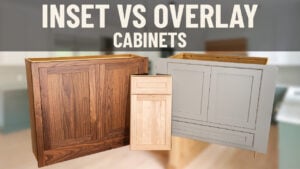Video Transcript
Hey everybody, Brian from the Cabinet Joint.
If you're a really brave soul, you can order your products from Conestoga unfinished. What that means is you're responsible for the painting and staining. What I want to talk about in this video is how the product comes to you, and how you would then finish it to get a good job.
So Conestoga takes care of a lot of the work for you. They have a couple of sanding options that your cabinet coach should automatically apply to your order whenever you're saying I want an unfinished product. And we're gonna be talking about solid wood. I'm not talking about MDF, I'm talking about solid wood today. Wood has grain, and wood will take stains differently depending on how it was sanded. Sanding is the paramount thing that you have to consider when you're trying to get a good finish. You don't just go to Lowe's and buy a can of Min wax and start splashing it on, or you're gonna have a blotchy mess. So what kind Conestoga does to really help you out is they have a couple of sanding options your sales rep, cabinet coach, will apply for you. One is called cross-grain removal. Wondering what is that? In the door production operation - anywhere, not just Conestoga - you have a door that's made with four pieces of framing and a center panel. The last operation before that door goes off to packaging or finishing or what have you is a wide belt sander. So they feed the door through a sander, and this giant sander is running this way - and it's going to sand the side pieces fine because the green runs this way, and the belt's going that way. Anywhere, we have a cross rail, the grain is against the grain of the sanding belt, and you end up with its scratches
running vertically on the top and bottom rail, and you're stain will soak into that. It will become an unsightly mess. Conestoga has this cross-grain removal option that we put through whenever you order unfinished. It will remove the cross grain scratches, as well as kind of denib the edges so you won't have rough edges here.
They also have a profile sanding option where Conestoga will take care of sanding your profiles nice and smooth. Where that becomes important is stain wants to penetrate the end grain. So if you don't do a good job sanding your perimeter and your edge profile, the stain will soak in much more here than it will on this with the green edge on the top and bottom. So you get kind of dark and then
light. So some of these sanding options really help you as the homeowner out by saving you probably five to six minutes a door with your little orbital palm sandal sander. Now what you have to remember is these are being wrapped and packed and shipped, and they're kind of rubbing, doing their thing in the truck, and you might have some polishing marks here and there.
What we do recommend is to get yourself a palm sander - most folks have one. You can buy one at Lowe's for about 45 bucks. Get 220 grit sandpaper, and just sand the flat areas of the door. Don't start rolling the sander off to the edge, or you're gonna start distorting your edge profile. Just stay in that flat area and go around the door a couple of times to get rid of any polishing marks. That's all you should have to do, and that door is now stain ready.
If you're staining, you may want to apply the stain in here the way Conestoga does, and then, using compressed air, try to blow your stain back into the panel groove so that you have some penetration of stain back under your framing bead. And that way, if your panel contracts a little bit due to humidity, you won't have unfinished wood showing. That's a trick Conestoga uses. They just puddle the stain up there and then blow it back under, and you can wipe the rest of your staying on, wipe it off real good and get that uniform look.
Some people also like using wood conditioners, especially on products like maple. Maple will get really blotchy. It'll take it light in some areas and darker in other areas. By using wood conditioner, it opens the grain in a uniform way, and then when you come back, follow the directions on the can; when you come back after the wood conditioner and apply or stain, it will be a much more even appearance. For some woods like cherry and hickory, and red oak, it doesn't matter, but for woods like maple or birch, you're going to want to use a wood conditioner.
So if you have any questions on wood finishing, always contact your cabinet coach and ask them. They'll be happy to help you. We strongly suggest -we're not just trying to sell it and don't take this as me as a sales pitch - finishing is not for the faint of heart. To lay out 15 or 20 doors in your garage, you have to finish both sides. You've got a top coat. It is usually two coats. It's a messy time-consuming job, and you're gonna be using brushes and rollers unless you've got an HVLP gun, and you're good at it, you're gonna end up with a product that's far inferior to what Conestoga is putting down with the robotics. So if you if you're willing to spend an extra 25-30 % on your job, just have the professionals do it. If you're backed into a corner, and you have to finish it yourself, we'll hope you get through it.
But remember, the results are on you. So if you call back and say hey, it didn't take well on this rail or whatever, Conestoga has no way of knowing if that was a you issue or the piece of wood was weird. So just remember what you're accepting for responsibility when you choose to play finisher. It's just not for the faint of heart.
So if you have any questions again, give your cabinet coach a call: 888-211-6482. And as always, thanks for watching.




